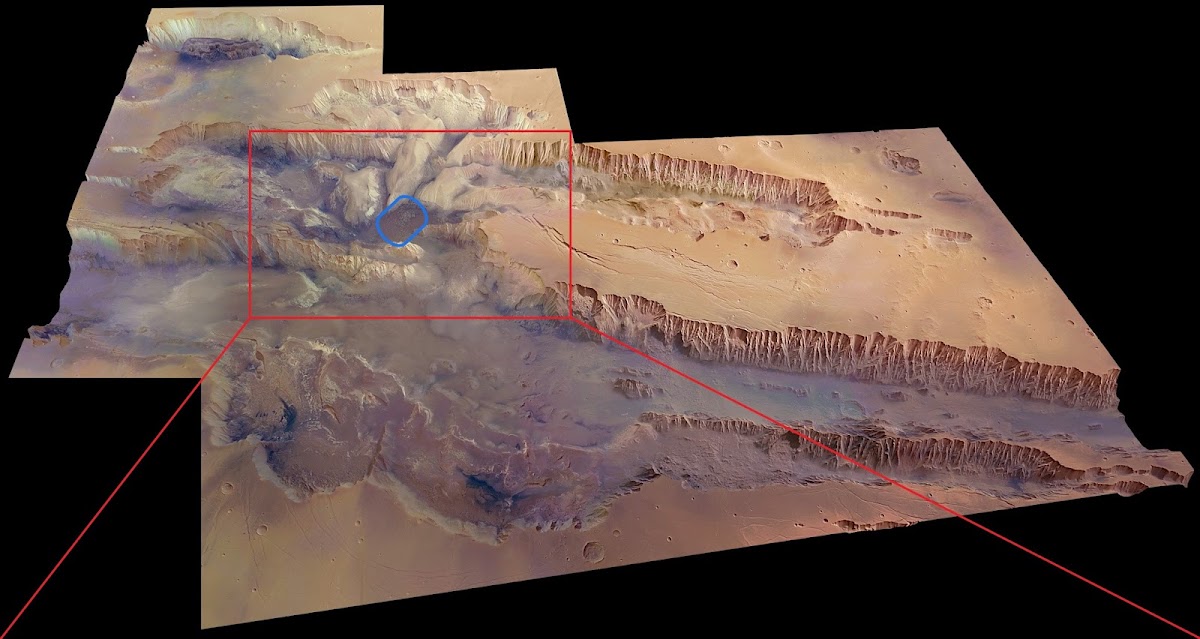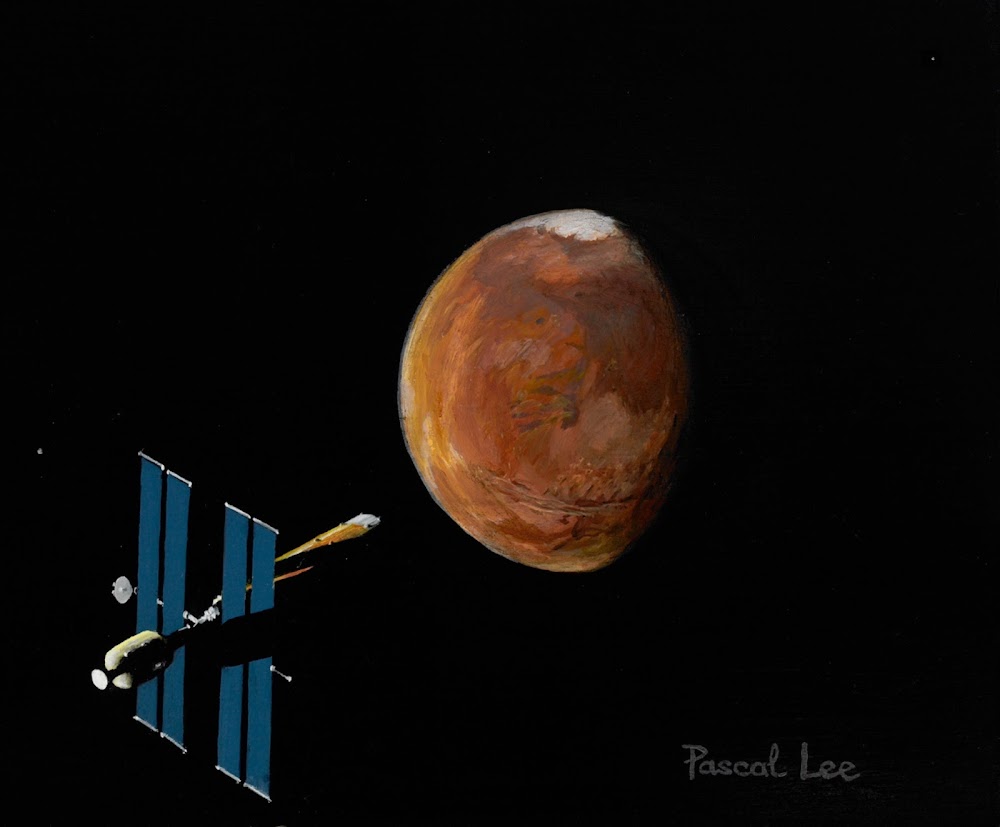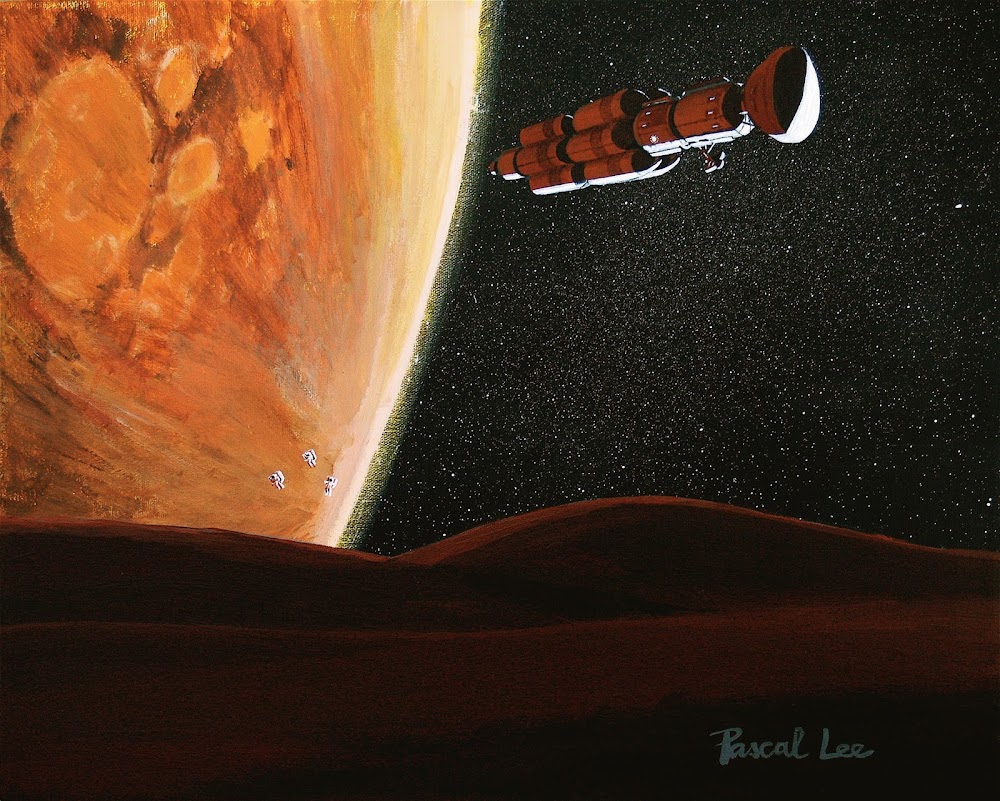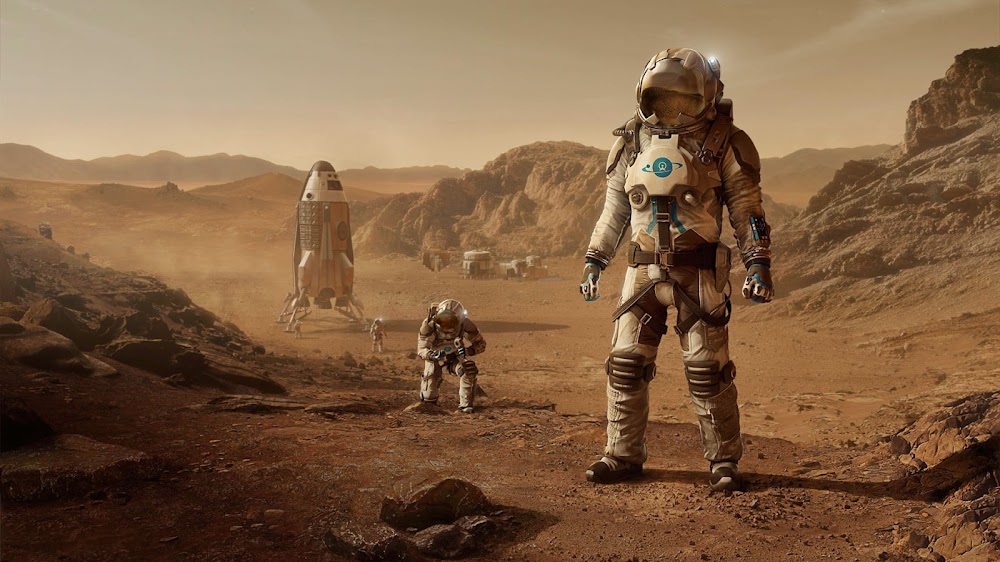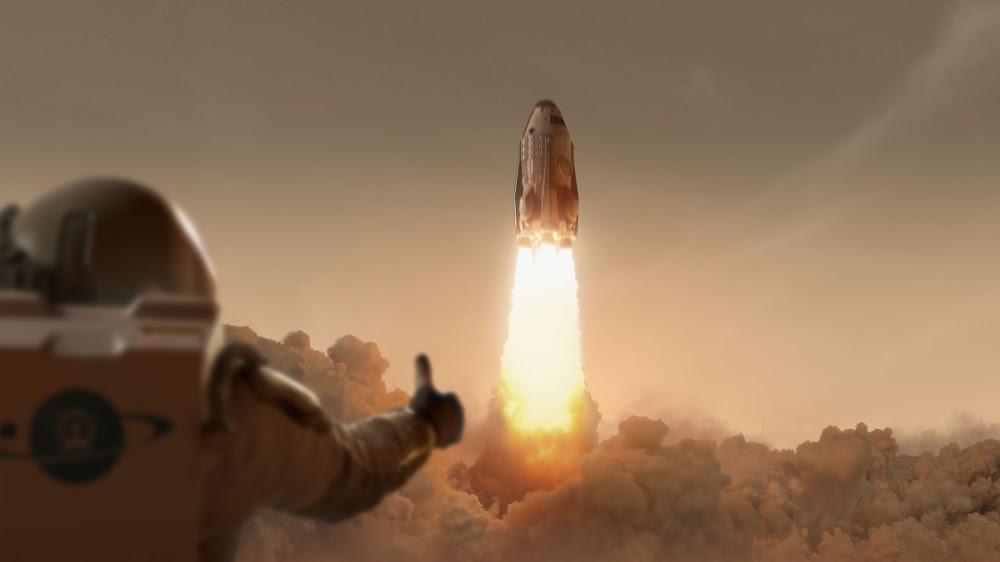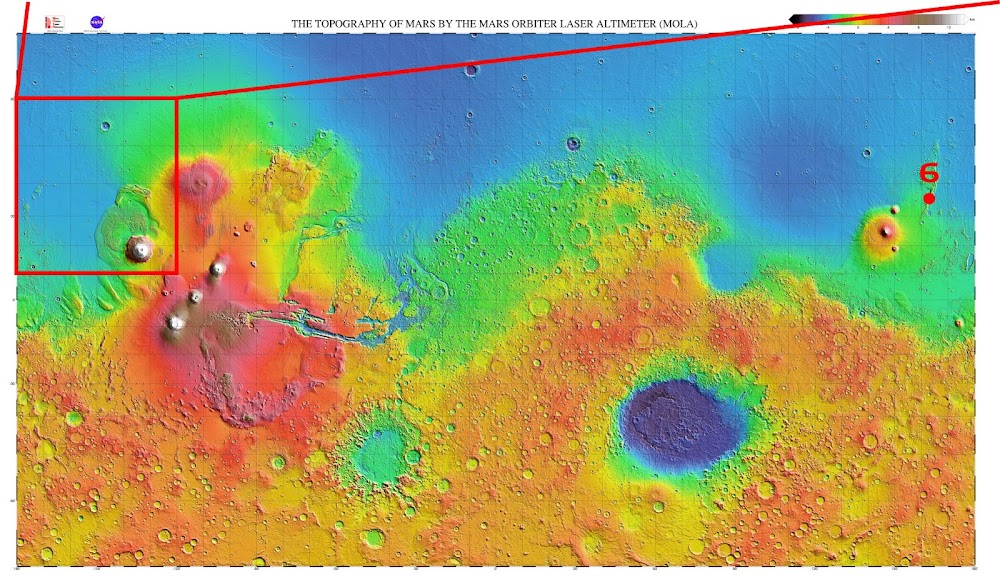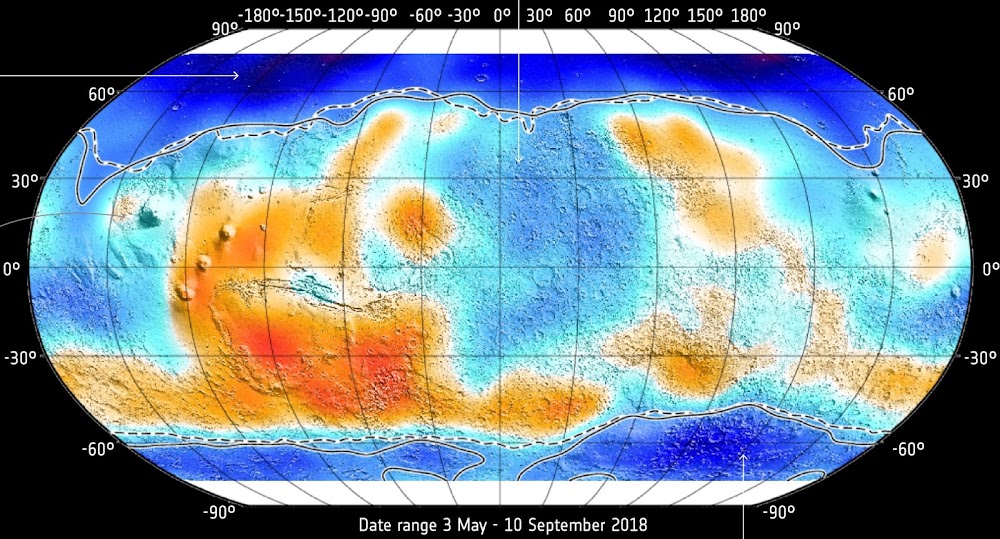The render is sourced from NASA's video "Pioneering Space" published 10 years ago:
Showing posts with label Mars Mission. Show all posts
Showing posts with label Mars Mission. Show all posts
Sunday, June 29, 2025
NASA's astronauts exploring Phobos
In this NASA concept rendering, an astronaut in a bulky EVA suit stands on the jagged, crater‑pocked surface of Phobos, Mars’s largest and closest moon, as the ruddy disk of Mars looms enormous on the horizon. The uneven regolith stretches out toward a steep crater rim, inside which a fleet of landers and robotic hopper vehicles carry out survey operations.
Friday, May 30, 2025
SpaceX Starship Mars mission update 2025
 On May 29th at Starbase, Texas SpaceX CEO and lead designer Elon Musk provided an update of SpaceX's Starship Mars architecture "The Road to Making Life Multiplanetary". Here are slides from his presentation.
On May 29th at Starbase, Texas SpaceX CEO and lead designer Elon Musk provided an update of SpaceX's Starship Mars architecture "The Road to Making Life Multiplanetary". Here are slides from his presentation.
Full presentation:
Slides from the presentation
Starship mission timeline for next 4 Earth-Mars transfer windows every 26 months:
The next opportunity is in the end of 2026, with landing in 2027:
SpaceX Mars mission in 2026:
SpaceX Mars mission in 2028:
Sunday, December 1, 2024
SpaceX Starship mission to Mars in 2030 - animated story by iamVisual
Sunday, February 5, 2023
Retrofuturistic Mars exploration base by Pascal Lee
In 2021 planetary scientist, the director of Haughton-Mars Project, Pascal Lee created a painting with the same, slightly updated scene of the first human exploration mission on Mars as in Chesley Bonestell's famous painting "Exploring Mars" featured in the 1956 book "The Exploration of Mars" by Willy Ley and Wernher Von Braun.
Highlighting Bonestell's legacy, Pascal Lee wrote: "In painting this new "Exploring Mars", I wanted to pay tribute to the grand master of space art and his creation of an iconic classic, but also update elements of the landscape and hardware in light of new knowledge gained about Mars in the intervening 65 years and evolutions in our thinking about future Mars exploration systems and human surface operations."
Highlighting Bonestell's legacy, Pascal Lee wrote: "In painting this new "Exploring Mars", I wanted to pay tribute to the grand master of space art and his creation of an iconic classic, but also update elements of the landscape and hardware in light of new knowledge gained about Mars in the intervening 65 years and evolutions in our thinking about future Mars exploration systems and human surface operations."
Comparison of Bonestell's (1956) and Lee's (2021) "Exploring Mars":
Tuesday, November 8, 2022
Animation of SpaceX Starship flying to Mars by iamVisual, narrated by Carl Sagan
YouTuber iamVisual has created a new animation "Wanderers" depicting SpaceX Starship's flight to Mars. The animation is narrated by Carl Sagan, the famous visionary of space exploration and colonization, reading from his 1994 book "Pale Blue Dot: A Vision of the Human Future in Space". Here you can watch the animation and see some images from it:
Sunday, December 19, 2021
Map of shallow subsurface water in Valles Marineris on Mars
On December 15 scientists from Space Research Institute of the Russian Academy of Sciences in Moscow, Russia revealed a discovery of an area with an unusually large amount of hydrogen in the Valles Marineris canyon system on Mars. Assuming the hydrogen is bound into water molecules, as much as 40% of the near-surface material in Candor Chaos region appears to be water. The discovery was made by neutron detector FREND on ESA&Roscosmos's ExoMars Trace Gas Orbiter orbiting Mars since October 2016. FREND is mapping the distribution of hydrogen in the uppermost meter of the planet’s surface. Hydrogen indicates the presence of water, being one of the constituents of the water molecule; it can also indicate water absorbed into the surface, or minerals that were formed in the presence of water.
While water is known to exist on Mars, most is found in the planet’s cold polar regions as ice. Typically water ice is not found exposed at the surface near the equator, as temperatures there are not cold enough for exposed water ice to be stable. Minerals seen in this part of Mars typically contain only a few percent water, much less than is evidenced by these new observations. “We found a central part of Valles Marineris to be packed full of water – far more water than we expected. This is very much like Earth’s permafrost regions, where water ice permanently persists under dry soil because of the constant low temperatures,” told one of the scientists involved in the study.
These are very inspiring discoveries for the future human colonization of Valles Marineris region we have imagined in our speculative Mars Colonization Timeline!

⇧ In the area C up to 40% of the near-surface material appears to be composed of water (by weight).
HERE is global-scale map of shallow subsurface water distribution on Mars published in 2019.
While water is known to exist on Mars, most is found in the planet’s cold polar regions as ice. Typically water ice is not found exposed at the surface near the equator, as temperatures there are not cold enough for exposed water ice to be stable. Minerals seen in this part of Mars typically contain only a few percent water, much less than is evidenced by these new observations. “We found a central part of Valles Marineris to be packed full of water – far more water than we expected. This is very much like Earth’s permafrost regions, where water ice permanently persists under dry soil because of the constant low temperatures,” told one of the scientists involved in the study.
These are very inspiring discoveries for the future human colonization of Valles Marineris region we have imagined in our speculative Mars Colonization Timeline!

⇧ In the area C up to 40% of the near-surface material appears to be composed of water (by weight).
The most water-rich area in Valles Marineris region is located in Candor Chaos:
HERE is global-scale map of shallow subsurface water distribution on Mars published in 2019.
Monday, December 6, 2021
SpaceX Legacy: episode 1: Manned Mission to Mars
YouTuber iamVisual has started to produce animated short series about the legacy of SpaceX – the leading NewSpace company developing innovative and cost-effective rocket and space technologies, including the first fully and rapidly reusable rocket system – two-stage super heavy-lift Starship rocket. The 1st episode of the series visualizes first human mission to Mars. You can watch it here:
Sunday, November 28, 2021
Human mission to Martian moons Phobos and Deimos by Pascal Lee
 Over the years planetary scientist, the director of Haughton-Mars Project, Pascal Lee has created a set of paintings depicting human mission to the Martian moons Phobos and Deimos. Here are several of them. More of his Mars related paintings here.
Over the years planetary scientist, the director of Haughton-Mars Project, Pascal Lee has created a set of paintings depicting human mission to the Martian moons Phobos and Deimos. Here are several of them. More of his Mars related paintings here.
Spaceship approaching Mars with Phobos and Deimos in sight:
Landing on Deimos, the farthest and smallest of the two Martian moons:
Astronauts exploring Deimos:
Landing on Phobos, the closest and largest of the two Martian moons:
Tuesday, November 2, 2021
Mars outpost by Robert McCall
 Picture of the Day 02/11/2021 - An early human outpost on Mars consisting of several landers and rovers by classical space artist Robert McCall.
Picture of the Day 02/11/2021 - An early human outpost on Mars consisting of several landers and rovers by classical space artist Robert McCall.
Monday, September 13, 2021
Infographic of SpaceX Starship timeline by Ryan MacDonald
Exoplanet astronomer at Cornell University's Carl Sagan Institute Ryan MacDonald (known on social media as Martian Colonist) has created an infographic of SpaceX's aspirational timeline for Starship's first missions to the Moon and Mars.
We estimate realistically the timeline will slip for a few years with #dearMoon mission happening in 2025, Lunar Starship demo landing in 2026, humans returning to the Moon in 2027, first cargo mission landing on Mars in 2027 and first crew mission landing on Mars in 2031.
We estimate realistically the timeline will slip for a few years with #dearMoon mission happening in 2025, Lunar Starship demo landing in 2026, humans returning to the Moon in 2027, first cargo mission landing on Mars in 2027 and first crew mission landing on Mars in 2031.
Saturday, August 28, 2021
First Russian cosmonauts on Mars by Alexander Ovcharenko
First Russian cosmonauts on Mars by freelance concept artist Alexander Ovcharenko (Александр Овчаренко) for Project "СССР-2061" - a community of Russian artists and writers envisioning Soviet Union in 2061 in an alternate reality. In 2011 they held their 1st arts contest asking participants to envision Soviet Union on Mars 50 years into the future. More images for the project here.
Tuesday, March 2, 2021
SpaceX has downselected 7 potential Mars landing sites for Starship
On September 2019 it was revealed SpaceX has selected several Starship candidate landing sites on Mars. The candidate sites were located in Southern Arcadia Planitia East of Erebus Montes and one in Phlegra Montes.
Since then SpaceX has conducted several workshops with the Mars science community to evaluate and narrow the list of candidate landing sites. All the sites must fit several criteria:
Recently an abstract with the conclusions has been published (the results of the study will be presented in two weeks, at the 52nd Lunar and Planetary Science Conference), pointing out 4 prime and 3 secondary potential Starship landing sites selected for further study and located in Phlegra Montes, Erebus Montes and Southern Arcadia Planitia:
We highlighted selected ★ prime and ★ secondary sites on the map:
Since then SpaceX has conducted several workshops with the Mars science community to evaluate and narrow the list of candidate landing sites. All the sites must fit several criteria:
- close to significant deposits of water/ice, a required resource for in situ propellant production and a consumable to support habitation;
- elevation below -2 km (with respect to the MOLA geoid) that can support the delivery of large payloads, with -3 km preferred;
- latitude must be <40° for solar power and thermal management, and closer to the equator is desirable;
- multiple separate landing locations spaced within a few km of each other, to support the multiple missions needed to grow an outpost;
- slopes should be <5° over a 10 m length scale and the chance of impacting a rock greater than 0.5 m high (1 m diameter) should be <5%;
- landing site must be radar reflective to enable measurement of the distance to the surface, and it must be load bearing to support the spacecraft at touchdown.
Recently an abstract with the conclusions has been published (the results of the study will be presented in two weeks, at the 52nd Lunar and Planetary Science Conference), pointing out 4 prime and 3 secondary potential Starship landing sites selected for further study and located in Phlegra Montes, Erebus Montes and Southern Arcadia Planitia:
- PM-1 has the lowest latitude and elevation of the Phlegra Montes sites, a clear association with LDAs (local ice deposits expressed as lobate debris aprons), well developed polygons (one of the indicators of ice-related morphologies), and has the highest SWIM (Subsurface Water Ice Mapping) score for geomorphic indicators of ice;
- AP-1 (Arcadia Planitia) appears to be one of the safest sites and has a moderate combined SWIM score for ice;
- AP-9 has the thickest ice from radar returns (of the Arcadia Planitia sites) and geomorphology indicating shallow ice. It has the highest combined SWIM score for ice, but appears slightly rocky and rough;
- EM-16 has a clear association with an LDA with nearby brain terrain and the strongest radar return for shallow ice and the highest combined SWIM score of the Erebus Montes sites;
- AP-8 (Arcadia Planitia) appears to be one of the safest sites and has the highest neutron and combined SWIM scores for ice;
- EM-15 (Erebus Montes) is associated with a prominent but less extensive LDA, has well developed polygons, nearby brain terrain and appears smooth;
- PM-7 is adjacent to lineated valley fill (attributed to glacial flow) and appears to be the safest of the Phlegra sites.
We highlighted selected ★ prime and ★ secondary sites on the map:
Friday, February 19, 2021
Landing site of Perseverance Mars 2020 rover
On February 18th NASA successfully landed its Mars 2020 Perseverance rover on Mars in Jezero Crater (Western Isidis Planitia). As you may wonder where it is, we placed Perseverance's landing location on the map of Mars by National Geographic Society:
Open link in new tab to view the map in full resolution.
NASA's Jet Propulsion Laboratory has created an animated flyover of the Martian surface explaining why Jezero Crater, a 28-mile-wide ancient lake-delta system, is the best place for Perseverance to find and collect promising samples for a possible future return to Earth. The animation also reveals the route Perseverance will travel in the first years after landing:
Wednesday, February 17, 2021
NASA Mars 2020 Perseverance rover landing in infographics
Tomorrow, on February 18, NASA will land its Mars 2020 Perseverance rover on Mars in Jezero Crater (Western Isidis Planitia). Its mission is to collect samples for later retrieval and it is accompanied by a small reconnaissance drone-helicopter Ingenuity - the first such craft on Mars. We will be able to watch NASA's broadcast of the landing here (starting on 19:15 UTC).
Here is an excellent infographic of Perseverance's landing sequence by Australian space illustrator Tony Bela:
Open link in new tab to view the infographic in its original resolution.
Monday, May 25, 2020
SpaceX Red Dragon entering Mars' atmosphere by Chris Monson
Sunday, February 16, 2020
Animation envisioning first human mission to Mars
Images and video animation envisioning first human mission to Mars created by Taylor James design studio for a health care campaign "Destination Survival" by Sudler & Hennessey London.
Sunday, September 1, 2019
Candidate sites for SpaceX Starship Mars landings revealed
[on September 2 info & map updated with additional two possible landing sites]
Robert Zimmerman from BehindTheBlack.com has found several images labelled as "Candidate Landing Site for SpaceX Starship [..]" in the latest data release from University of Arizona's HiRISE camera (aboard NASA's Mars Reconnaissance Orbiter). It means that with help from NASA SpaceX is already quietly evaluating the best place where to land first Starships on Mars. Here are direct links to HiRISE image of: Site 1, Site 2, Site 3, Site 4, Site 5 (in Arcadia Planitia) & Site 6 (in Phlegra Montes).
For several years it hasn't been a secret SpaceX is considering four Martian regions for landings: Deuteronilus Mensae, Phlegra Montes, Utopia Planitia and southern Arcadia Planitia. But even in 2017 southern Arcadia Planitia looked "more promising", according to Paul Wooster, Principal Mars Development Engineer at SpaceX. So by now SpaceX may very well be down to evaluating more precise landing sites in that region.
All the candidate landing sites (except #6 in Phlegra Montes) are located on the border between Amazonis Planitia and Arcadia Planitia. According to latest data, Arcadia Planitia is one of the few regions where abundant shallow ice is present at relatively low latitudes. There is strong evidence that this location holds buried ice glaciers. So it has two critical elements looked by SpaceX for its Mars Base Alpha: solar energy and water. Those are critical not only for life support but also for refueling Starships. It's also in low altitude meaning a bit higher air pressure than in higher areas on Mars; that is beneficial for radiation protection and creates more atmospheric drag during the landing.
Robert Zimmerman from BehindTheBlack.com has found several images labelled as "Candidate Landing Site for SpaceX Starship [..]" in the latest data release from University of Arizona's HiRISE camera (aboard NASA's Mars Reconnaissance Orbiter). It means that with help from NASA SpaceX is already quietly evaluating the best place where to land first Starships on Mars. Here are direct links to HiRISE image of: Site 1, Site 2, Site 3, Site 4, Site 5 (in Arcadia Planitia) & Site 6 (in Phlegra Montes).
For several years it hasn't been a secret SpaceX is considering four Martian regions for landings: Deuteronilus Mensae, Phlegra Montes, Utopia Planitia and southern Arcadia Planitia. But even in 2017 southern Arcadia Planitia looked "more promising", according to Paul Wooster, Principal Mars Development Engineer at SpaceX. So by now SpaceX may very well be down to evaluating more precise landing sites in that region.
All the candidate landing sites (except #6 in Phlegra Montes) are located on the border between Amazonis Planitia and Arcadia Planitia. According to latest data, Arcadia Planitia is one of the few regions where abundant shallow ice is present at relatively low latitudes. There is strong evidence that this location holds buried ice glaciers. So it has two critical elements looked by SpaceX for its Mars Base Alpha: solar energy and water. Those are critical not only for life support but also for refueling Starships. It's also in low altitude meaning a bit higher air pressure than in higher areas on Mars; that is beneficial for radiation protection and creates more atmospheric drag during the landing.
We made a map of all of the candidate sites:
Tuesday, July 30, 2019
Mission to Phobos by Ludovic Celle
Picture of the Day 30/7/2019 - Spacecraft approaching the largest and closest of the two [asteroid size] Martian moons - Phobos - by French graphic artist Ludovic Celle. More of his Mars art here.
Wednesday, May 1, 2019
SpaceX. Raising the bar!
"Do it", as Elon Musk bluntly replied to the bragging of Boeing's CEO about "beating Elon Musk to Mars" 😁
These days SpaceX is the leading NewSpace company developing innovative and cost-effective rocket/space technologies and beating all the "space dinosaurs" in the field. Its ultimate goal is to colonize Mars. In the spirit of this reality Instagram user starjet_pilot has made this retro style poster (recalling the iconic photography of US soldiers raising the flag on Iwo Jima by Joe Rosenthal) of starmen raising the flag of SpaceX on Mars with the Starship in the background.
These days SpaceX is the leading NewSpace company developing innovative and cost-effective rocket/space technologies and beating all the "space dinosaurs" in the field. Its ultimate goal is to colonize Mars. In the spirit of this reality Instagram user starjet_pilot has made this retro style poster (recalling the iconic photography of US soldiers raising the flag on Iwo Jima by Joe Rosenthal) of starmen raising the flag of SpaceX on Mars with the Starship in the background.
Thursday, April 11, 2019
Map of shallow subsurface water distribution on Mars
On March 10 ESA has revealed the first results from ExoMars Trace Gas Orbiter orbiting Mars since October 2016. Among the data there is the best map of shallow subsurface water distribution on Mars ever created. The map is made by orbiter's neutron detector FREND mapping the distribution of hydrogen in the uppermost metre of the planet’s surface. Hydrogen indicates the presence of water, being one of the constituents of the water molecule; it can also indicate water absorbed into the surface, or minerals that were formed in the presence of water.
- Blue areas - more water
- Orange areas - less water
Subscribe to:
Comments (Atom)





 Canadian VFX artist and YouTuber
Canadian VFX artist and YouTuber 




